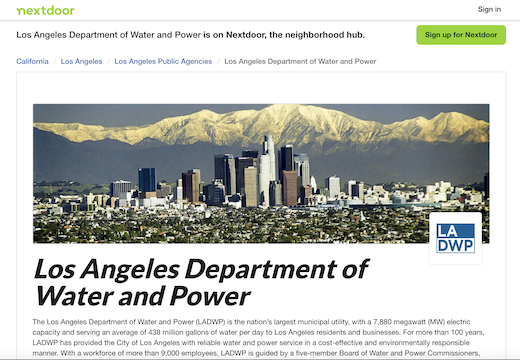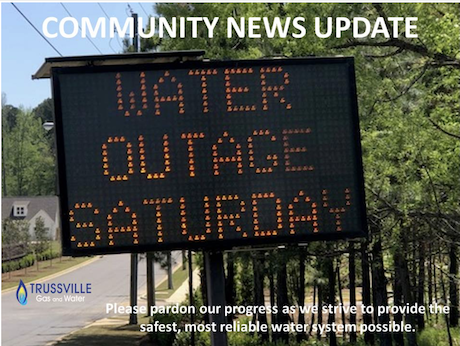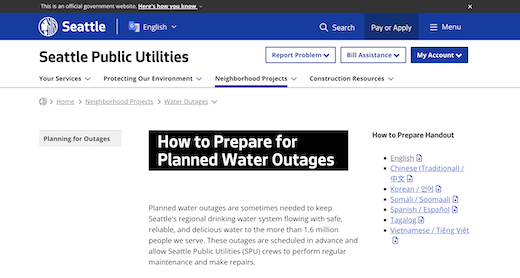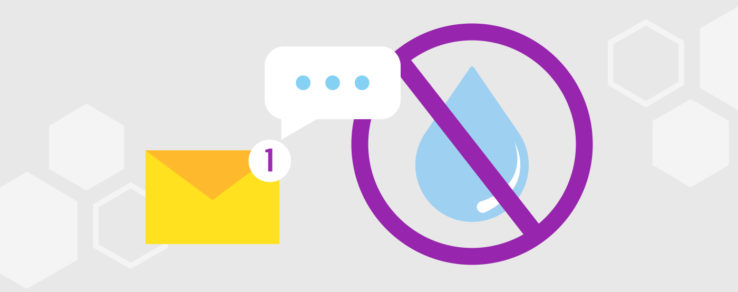For water utilities, ensuring a constant supply of clean and safe water is paramount. However, maintenance, repairs and unforeseen circumstances can lead to temporary water interruptions.
These planned interruptions, while necessary, can often cause significant inconvenience to customers. Therefore, it’s crucial that water utilities implement an effective water utility communication plan to notify customers and manage expectations.
“With planned water interruptions, we have a more precise idea of the scope of the work, and therefore, can more accurately predict how long it will take and how long the customer will be without water,” says John Cox, General Superintendent of the Water Distribution Division, Los Angeles Department of Water and Power (LADWP). “We have the benefit of time and can do a more thorough job of providing notifications.”
Creating a Water Utility Communication Plan
A successful communications plan for planned water interruptions is essential. It not only prepares customers for what they can expect, but also positions your water utility as a transparent and trusted resource. Clear communication is key.
- Identify affected customers: Notify all customers affected by the water interruption. In addition to residential customers, consider local businesses, schools and hospitals that might need special preparations.
- Define key messages: Keep messages clear, concise and empathetic. Explain the reason for the interruption, the anticipated duration and any steps customers should take. Water interruption communications should answer as many customer questions as possible.
- Choose communication channels: Ensure your water utility reaches as many customers as possible with a multichannel water utility communications plan. This might include emails, bill inserts, social media, website content, educational webinars, community events, call center scripts and more.
- Coordinate with respective support groups: Collaborate with the necessary groups, whether community partners, local media, government departments or other agencies to get the message out to local businesses and residents.
- Have a contingency plan: If the water interruption goes longer than expected, make sure you have a plan B to mitigate negative customer experiences.
Notifying Customers About Water Interruptions
The foundation of any successful water utility communication plan is proactive outreach. When water utilities foresee an interruption, they should immediately inform affected customers. This advance warning allows customers to make necessary preparations, such as storing water or making changes to their schedule or business operations.
In addition to proactive communications, transparency is key. With a planned water interruption, utilities should provide affected customers with as much information as possible. Remember, the difference between a minor inconvenience and a major grievance often lies in the effectiveness of your communications strategy in setting customer expectations.
Essential information in a water utility communication plan includes:
- The reason for the interruption: Whether it’s maintenance, upgrades or emergency repairs, explaining the reason for the planned water disruption helps build customer trust, confidence and understanding.
- Start and end time: Clearly state when the water service will be interrupted and when it is expected to resume.
- Affected areas: Detail which neighborhoods or areas will be affected to avoid unnecessary concern among unaffected customers.
- Preparation tips: Offer advice on how customers can prepare, such as storing water, not turning on the faucet, and more.
- Alerts and contact information: Provide information on where to get updates and who to contact with questions. This might include a link to sign up for utility alerts.
Channels to Communicate with Water Utility Customers
Utilizing multiple communication channels ensures that your message reaches as broad an audience as possible. Here are several effective channels for a water utility communication plan:
- Door hangers and letters: Traditional media like door hangers, letters and bill inserts are an effective way to reach customers.
- Social media: Platforms like Facebook, X (Twitter) and Instagram are invaluable for reaching a wide audience. Updates on social media can keep the public updated in real time.
- SMS alerts: Text messages are an excellent way to directly notify customers, especially for time-sensitive information.
- Email notifications: For detailed updates, including maps and other visual elements, email marketing is an effective tool.
- Website updates: Maintain a dedicated section on your website for planned water interruptions where customers can find detailed information and updates.
- Local media: For extensive water interruptions, partnering with local newspapers, radio stations and TV channels can enhance outreach.
According to Cox, LADWP gives customers at least 72 hours advanced notice before any planned water outages. The project team, which can include contractors and LADWP crews, distributes notices to customers as part of the water utility communication plan.
Door hangers containing notification letters with pertinent information is the most effective method for communicating with their customers. LADWP shares the date and time of the interruption, the reason for the interruption as well as contact information in case they’d like to reach out for more details. Since water interruptions are an inconvenience, it’s also imperative to thank customers for their patience.
“We tend to deliver those letters door-to-door, and often we encounter the customer in person during this process,” Cox says. “Therefore, we have the benefit of explaining the upcoming work that we plan to do and the impact to the area. Door-to-door notification is the most effective method for us because it ensures that each affected resident will receive written notification at their home.”
For larger planned water interruptions, LADWP’s Community Affairs team will post information on the social media platform Nextdoor, which allows users to geotarget to a specific group. This ensures that the message is sent to affected customers.

“If a significantly large area will be experiencing a planned water interruption, we may also contact the local Neighborhood Council,” Cox says. “They can help notify customers through their channels and contacts. Using both letters and Nextdoor tends to be sufficient to blanket an affected area under normal circumstances.”
Trussville Gas & Water, which services customers in Alabama, is dedicated to proactive communications about planned water interruptions. The utility underwent a major 10-month infrastructure project to replace 2.5 miles of water pipeline, which caused temporary water interruptions for approximately 900 residents.
Their water utility communication plan featured multiple communication channels, including digital and traditional platforms. To notify affected customers, Trussville Gas & Water placed large signs in front of affected subdivisions in the community.

Additionally, the utility updated customers on their website and Facebook page. To reach a wider audience, they also reached out to the local newspaper, the Trussville Tribune, to publish project updates.
Communicating Water Interruptions to Business Customers
When it comes to communicating planned water interruptions to business customers, utilities must take a different approach. Collaboration with local businesses and community partners is vital.
For multifamily buildings and apartments, Seattle Public Utilities works with landlords and management companies to ensure residents are aware of the water interruption and know what steps they need to take.

Additionally, the utility works with local businesses to determine the best time to shut off water to mitigate the negative impact on operations. As a result, water interruptions may take place overnight or after business hours.
LADWP’s Customer Service Key Accounts team and Corporate Communications and Strategy Division’s Community Affairs are vitally important to the utility’s communication plan. Both teams help to minimize the impact of planned water interruptions at hospitals and schools.
“The impact to a school or hospital is much greater than a single residence,” Cox says. “That’s why it’s ideal to have as much advanced planning time as possible to make sure that the business customers in question — especially sensitive institutions like hospitals and schools — are fully informed and prepared for a water interruption.”
Additionally, LADWP’s Legislative and Intergovernmental Affairs group is responsible for communicating any significant projects to the local council district and/or mayor’s office. Those governmental entities can often help spread the word and alert business customers when a significant interruption is planned.
Why a Water Utility Communication Plan is Important
A robust communication plan does more than inform — it builds and maintains trust with customers. Here are a few reasons why water utilities should develop a communication strategy for planned water interruptions:
- Minimizes disruption: By allowing customers to prepare, you can lessen the impact of the water interruption on their daily lives.
- Maintains customer trust: Transparent and timely communication demonstrates that you value your customers and their experience.
- Enhances reputation: Utilities that communicate effectively are often perceived as more reliable, trustworthy and customer-centric.
While planned water interruptions can be an inconvenience for customers, they also provide utilities with an opportunity to improve trust and long-term customer satisfaction. By developing a comprehensive water utility communication plan and utilizing the right channels to share essential information, utilities can minimize inconvenience and build stronger customer relationships over time.

